《大学英语》课程教学大纲B
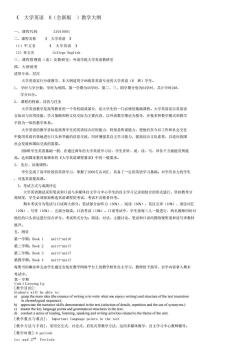
《大学英语B(全新版)教学大纲 、课程代码 33010001 二、课程名称 《大学英语》 (1)中文名 《大学英语》 (2)革文名 College English 三、课程管理院(系)及教研室:外语学院大学英语教研室 四、大纲说明 适用专业、层次 大学英语实行分级教学,本大纲适用于06级非英语专业的大学英语(B班)学生。 1、学时与学分数:学时为周四,第一学期为56学时,第二、三、四学期分别为64学时,共计学时248, 学分16分 2、课程的性质、目的与任务 大学英语教学是高等教有的一个有机组成部分,是大学生的一门必修的基础课程。大学英语是以英语语 知识与应用技能、学习策略和跨文化交际为主要内容,以外语教学理论为指导,并集多种教学模式和教学 手段为一体的教学体系。 大学英语的教学目标是培养学生的英语综合应用能力,特别是听说能力,使他们在今后工作和社会交往 中能用英语有效地进行口头和书面的信息交流,同时增强其自主学习能力,提高综合文化煮养,以适应我国 社会发展和国际交流的需要。 因B班学生英语基础一般,在通过两年的大学英语学习后,学生在听、说、读、写、译各个方面能有所提 高。达到国家教有部额布的《大学英语程要求》中的一般要求。 3、先行、后续课程: 学生完成了高中阶段的英语学习,掌握了2000左右词汇,具备了一定的英语学习基础。对学有余力的学生 可选英语提高课。 5、考试方式与成绩评定 大学英语测试采用笔试和口试与多媒体自主学习中心学生的自主学习记录相结合的形式进行,坚持教考分 离制度,学生必须参加所选英语课程的考试,考试不及格者补考, 期末考试分为笔试与口试两大部分,笔试部分由听力(30%)、阅读(30%)、英汉互译(10%)、语法词江 (10%)、写作(10%)、五部分组成。口语考试(10%)。口语考试中,学生按每三人一组进行,两名教师同时对 他们的口头表达进行综合评分。考试形式分为:朗读、对话、主题讨论。笔试和口试均围绕视听说和读写译教材 展开。 五、纲目 第一学期:B0ok1 unitl-unit6 第二学期:Book2 unitl-unit? 第三学明。B003 unitl-unit? 第四学期:B0ok4 unit1-unit7 每册书的剩余单元由学生通过安装在教学网络平台上的教学软件自主学习,教师给子指导,自学内容拿入期末 考试中 sence of writing is to write what one enjoys writing)and structure of the text (narration d)to the theme of the unit 【教学重点与难点]:Important language points in the text [教学方法与手段]:采用交互式、讨论式、启发式等教学方法,运用多媒体教学,白主学习中心教师辅导 [教学时数]:6 periods 1st and 2nd Periods
《 大学英语 B(全新版 )教学大纲 一、课程代码 33010001 二、课程名称 《 大学英语 》 (1)中文名 《 大学英语 》 (2)英文名 College English 三、课程管理院(系)及教研室:外语学院大学英语教研室 四、大纲说明 适用专业、层次 大学英语实行分级教学,本大纲适用于06级非英语专业的大学英语(B 班)学生。 1、 学时与学分数:学时为周四,第一学期为56学时,第二、三、四学期分别为64学时,共计学时248, 学分16分。 2、 课程的性质、目的与任务 大学英语教学是高等教育的一个有机组成部分,是大学生的一门必修的基础课程。大学英语是以英语语 言知识与应用技能、学习策略和跨文化交际为主要内容,以外语教学理论为指导,并集多种教学模式和教学 手段为一体的教学体系。 大学英语的教学目标是培养学生的英语综合应用能力,特别是听说能力,使他们在今后工作和社会交往 中能用英语有效地进行口头和书面的信息交流,同时增强其自主学习能力,提高综合文化素养,以适应我国 社会发展和国际交流的需要。 因B班学生英语基础一般,在通过两年的大学英语学习后,学生在听、说、读、写、译各个方面能有所提 高。达到国家教育部颁布的《大学英语课程要求》中的一般要求。 3、 先行、后续课程: 学生完成了高中阶段的英语学习,掌握了2000左右词汇,具备了一定的英语学习基础。对学有余力的学生 ,可选英语提高课。 5、考试方式与成绩评定 大学英语测试采用笔试和口试与多媒体自主学习中心学生的自主学习记录相结合的形式进行,坚持教考分 离制度,学生必须参加所选英语课程的考试,考试不及格者补考。 期末考试分为笔试与口试两大部分。笔试部分由听力(30%)、阅读(30%)、英汉互译(10%)、语法词汇 (10%)、写作(10%)、五部分组成。口语考试(10%)。口语考试中,学生按每三人一组进行,两名教师同时对 他们的口头表达进行综合评分。考试形式分为:朗读、对话、主题讨论。笔试和口试均围绕视听说和读写译教材 展开。 五、纲目 第一学期:Book 1 unit1-unit6 第二学期:Book 2 unit1-unit7 第三学期:Book 3 unit1-unit7 第四学期:Book 4 unit1-unit7 每册书的剩余单元由学生通过安装在教学网络平台上的教学软件自主学习,教师给予指导,自学内容拿入期末 考试中。 第一学期 Unit 1 Growing Up [教学目的]: Students will be able to: a) grasp the main idea (the essence of writing is to write what one enjoys writing) and structure of the text (narration in chronological sequence); b) appreciate the narrative skills demonstrated in the text (selection of details, repetition and the use of synonyms.) c) master the key language points and grammatical structures in the text; d) conduct a series of reading, listening, speaking and writing activities related to the theme of the unit. [教学重点与难点]: Important language points in the text [教学方法与手段]:采用交互式、讨论式、启发式等教学方法,运用多媒体教学,自主学习中心教师辅导。 [教学时数]:6 periods 1st and 2 nd Periods
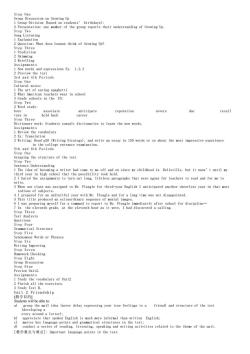
ussion on Growing U tatiooreorepr understanding of Gro Up. Ex hat dose Lennon think of Growing Up? 3 Retelling Periods eating spaghetti in school chools in the US bore anticipate reputation severe due recall are iieoThre work:Students consult dictionaries to learn the new words. bulary Translatio an essay in 150 vords or so bout the ost ressive experience the structure of the text Understanding me off and on since sy childhood in Belleville,but it wasn't until possibilifeless paragraphs that were agony for teachers to read and for me to 3hen our class as assigned to Mr.Fleagle for third-year English I anticipated another cheerless year in that ost for This titlep fruitful year with Mr.Fleagle and for a long time was not disappointed. s Words or Phrases Preview Unit2. abulary of Unit2 e the exe il idea (never delay expressing your true feelings to a friend)and structure of the text that spoken ries of reading.listening.spea aking and writing activities related to the theme of the unit. 教学重点与难点]:Iaportant language points in the text
Step One Group Discussion on Growing Up 1 Group Division (based on students’ birthdays): 2 Presentation: one member of the group reports their understanding of Growing Up. Step Two Song Listening 1 Explanation 2 Question: What dose Lennon think of Growing Up? Step Three 1 Prediction 2 Skimming 3 Retelling Assignments 1 New words and expressions Ex. 1.2.3 2 Preview the text 3rd and 4th Periods Step One Cultural notes: 1 The art of eating spaghetti 2 What American teachers wear in school 3 Grade schools in the US: Step Two 2 Word study: bore associate anticipate reputation severe due recall turn in hold back career Step Three Dictionary work: Students consult dictionaries to learn the new words. Assignments 1 Review the vocabulary 2 Ex: Translation 3 Writing: Read p28 (Writing Strategy), and write an essay in 150 words or so about the most impressive experience in the college entrance examination. 5th and 6th Periods Step One Grasping the structure of the text Step Two Sentence Understanding 1 The idea of becoming a writer had come to me off and on since my childhood in Belleville, but it wasn’t until my third year in high school that the possibility took hold. 2 I hated the assignments to turn out long, lifeless paragraphs that were agony for teachers to read and for me to write. 3 When our class was assigned to Mr. Fleagle for third-year English I anticipated another cheerless year in that most tedious of subjects. 4 I prepared for an unfruitful year with Mr. Fleagle and for a long time was not disappointed. 5 This title produced an extraordinary sequence of mental images. 6 I was preparing myself for a command to report to Mr. Fleagle immediately after school for discipline. 7 In the eleventh grade, at the eleventh hour as it were, I had discovered a calling. Step Three Text Analysis Questions Step Four Grammatical Structure Step Five Synonymous Words or Phrases Step Six Writing Improving Step Seven Homework Checking Step Eight Group Discussion Step Nine Preview Unit2. Assignments 1 Study the vocabulary of Unit2 2 Finish all the exercises. 3 Study Text B. Unit 2 Friendship [教学目的] Students will be able to: a) grasp the mail idea (never delay expressing your true feelings to a friend) and structure of the text (developing a story around a letter); b) appreciate that spoken English is much more informal than written English; c) master key language points and grammatical structures in the text; d) conduct a series of reading, listening, speaking and writing activities related to the theme of the unit. [教学重点与难点]: Important language points in the text

【教学方法与手段]:采用交互式、讨论式、启发式等教学方法,运用多媒体教学,自主学习中心教师辅导。 [教学时数]:6 periods Do you often write letters to friends? Trick or treat Smell my feet Give me something to eat Step Four Gen ture (Ex p39) Dvithet parts and ive the d of ach pur or phrases in the text and find their proper meaning with assistance of the dictionary tep One estimate kind of/sort of a couple of come urge postpon Csiatioa every now and then Step Th ad e letter to the toacher,ying anything you y a Conver 一e盈that the arrator5oT时veelne theeie的woa Step Thre on (p4) Discus s your idea of friend ship?How important are friends to you? Step Four ces of work as example,praising the appreciable points and correcting the coon errors Assignments points. two great scientists:Stephen Hawking and Albert Einstein nd s writing activities related to the theme of the nit guage points in the text. 「教学方法与手段]:采用交互式、讨论式、启发式等教学方法,运用多煤体教学,自主学习中心教师辅导。 [教学时数]:6 periods
[教学方法与手段]:采用交互式、讨论式、启发式等教学方法,运用多媒体教学,自主学习中心教师辅导。 [教学时数]: 6 periods 1st and 2 nd Periods Step One Survey-Do you often write letters to friends? Step Two Song Listening Listen to the song and answer questions Step Three Cultural Notes Halloween Trick or treat Smell my feet Give me something to eat Step Four General Impression 1 Main idea of the text 2 Contents questions Step Five Text Structure (Ex p39) 1 Answer the clue questions 2 Divide the text into three parts and give the main idea of each part. Step Six Pronunciation Practice Assignments 1 List the difficult word or phrases in the text and find their proper meaning with assistance of the dictionary. 2 Ex vocabulary p43-46 3rd and 4th Periods Step One Skimming Questions Step Two Word Study available estimate kind of/ sort of a couple of come up urge postpone reunion go by hang out every now and then choke up destination skip correspondence Step Three Language Style 1 T reads out the following sentences and Ss try to find out sentences of similar meaning in the text: 2 Question: Which sentences are more colloquial? Assignments 1 Ex p45-47 2 Writing: read p56 and write a letter to the teacher, saying anything you want to say. 3 Learn Part2,3 5th and 6th Periods Step One Ways to Keep a Conversation Going From the text we can conclude that the narrator is very good at keeping the conversation going. Ss try to find the relevant examples. Step Two Translation (p49) Step Three Discussion: What’s your idea of friend ship? How important are friends to you? Step Four Comments on Ss’ Writing Take one or two pieces of work as example, praising the appreciable points and correcting the common errors. Step Five Homework Checking Assignments 1 Read Text B 2 Review Text A, mark the confusing points. 3 Study the vocabulary of Unit3 4 Look for the material about two great scientists: Stephen Hawking and Albert Einstein Unit 3 Understanding Science [教学目的]: Students will be able to: a) understand the main idea ( to ensure the survival of human civilization, measures must be taken to help the public understand science ) and structure of the text ( introducing a topic, developing the topic with supporting details, supplying a conclusion ); b) appreciate the style differences between narrative writing and expository writing; c) master key language points and grammatical structures in the text; d) conduct a series of reading, listening, speaking and writing activities related to the theme of the unit. [教学重点与难点]: Important language points in the text. [教学方法与手段]:采用交互式、讨论式、启发式等教学方法,运用多媒体教学,自主学习中心教师辅导。 [教学时数]: 6 periods
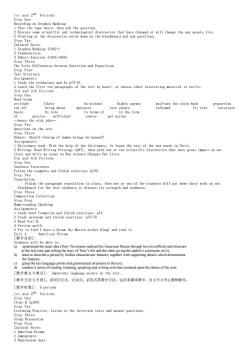
da Periods ask the question. Noreking (194) Albert Einstein (1879-1955) the te br come othernteret do without highly anyway rate e in the form heaeehgietriciear convey put across on the text on Th nments Read rii ctvet ct our 巴an也 学的1 of th Tony Tr 【敦学重点与难点]:Important language points in the text. [教学方法与手段]:采用交互式、讨论式、启发式等教学方法,运用多煤体教学,自主学习中心教师辅导 教学时数] 6 periods Ist and 2d Periods tep p106 Practice:Listen to the interview twice and answer questions
1st and 2 nd Periods Step One Recording on Stephen Hawking 1 Play the tape twice, then ask the question. 2 Discuss some scientific and technological discoveries that have changed or will change the way people live. 3 Pointing at the discoveries noted down on the blackboard and ask questions. Step Two Cultural Notes 1 Stephen Hawking (1942-) 2 Frankenstein: 3 Albert Einstein (1879-1955) Step Three The Style Differences between Narration and Exposition. Step Four Text Structure Assignments 1 Study the vocabulary and Ex p72-76 2 Learn the first two paragraphs of the text by heart, or choose other interesting material to recite. 3rd and 4th Periods Step One Word Study attitude likely do without highly anyway put/turn the clock back proportion cut off bring about moreover rate ensure informed fit into entertain basis by rote in terms of in the form of precise sufficient convey put across .hence the sick joke. Step Two Questions on the text Step Three Debate: Should cloning of human beings be banned? Assignments 1 Dictionary work: With the help of the dictionary, Ss learn the rest of the new words in Part1. 2 Writing: Read Writing Strategy (p87), then pick one or two scientific discoveries that have great impact on our lives and write an essay on How science Changes Our Lives. 5th and 6th Periods Step One Sentence Structures Follow the examples and finish exercises (p76) Step Two Translation: Finish the paragraph translation in class, then one or two of the students will put down their work on the blackboard for the rest students to discuss its strength and weakness. Step Three Composition Correction Step Four Home-reading Checking Assignments 1 Study word formation and finish exercises: p74 2 Study antonyms and finish exercises: p75-76 3 Read Text B. 4 Preview unit4. 5 Try to find I have a dream (by Martin Luther King) and read it. Unit 4 American Dream [教学目的]: Students will be able to: a) understand the main idea (Tony Trivisonno realized his American Dream through his own efforts) and structure of the text (one part telling the story of Tony’s life and the other giving the author’s comments on it); b) learn to describe a person by his/her characteristic features, together with supporting details which demonstrate the features; c) grasp the key language points and grammatical structures in the text; d) conduct a series of reading, listening, speaking and writing activities centered upon the theme of the unit; [教学重点与难点]: Important language points in the text. [教学方法与手段]:采用交互式、讨论式、启发式等教学方法,运用多媒体教学,自主学习中心教师辅导。 [教学时数]: 6 periods 1st and 2 nd Periods Step One Cloze B (p106) Step Two Listening Practice: Listen to the interview twice and answer questions: Step Three Group Discussion Step Four Cultural Notes: 1 American Dream: 2 Immigrants: 3 Depression days:
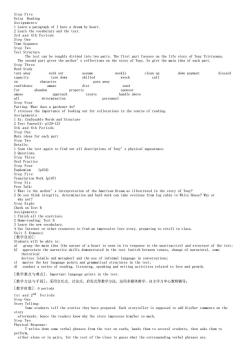
5efHo5Aiag 3rd ence ganswseesosi Stud work out weekly down payment discard capacity wreck pass away abandon iet propert create personnel oat for colto the c of tdescrptio of Tony (p104) n Work (p107) xt B he 5ernet or other resources to find an ispressive love story.preparing to retell in ela be able to conduct a series of reading,listening.speaking and writing activities related to love and growth [敦学重点与难点]:Important language points in the text, [教学方法与手段]:果用交互式、讨论式、启发式等教学方法,运用多媒体教学,自主学习中心教师辅导。 [教学时数]:6 periods Ist and 2nd Periods n some verbal phrases from the text on cards,hands thes to several students,then asks the to for the rest of the clas to ha the correspnding verbal pase are
Step Five Extra Reading Assignments 1 Learn a paragraph of I have a dream by heart. 2 Learn the vocabulary and the text. 3rd and 4th Periods Step One Time Sequence Step Two Text Structure The text can be roughly divided into two parts. The first part focuses on the life story of Tony Trivisonno. The second part gives the author’s reflections on the story of Tony. Ss give the main idea of each part. Step Three Word Study turn away work out assume weekly clean up down payment discard capacity turn down skilled wreck call on character pass away confidence amaze diet send for abandon property sponsor amuse approach create handle above all determination personnel Step Four Pairing: What does a gardener do? T stresses the importance of looking out for collocations in the course of reading. Assignments 1 Ex: Confusable Words and Structure 2 Test Yourself: p130-133 5th and 6th Periods Step One Main ideas for each part Step Two Details: 1 Scan the text again to find out all descriptions of Tony’s physical appearance. 2 Questions. Step Three Oral Practice Step Four Euphemism (p104) Step Five Translation Work (p107) Step Six Free Talk: 1 What is the author’s interpretation of the American Dream as illustrated in the story of Tony? 2 Do you think integrity, determination and hard work can take everyone from log cabin to White House? Why or why not? Step Eight Check on Text B Assignments 1 Finish all the exercises. 2 Home-reading: Text B 3 Learn the new vocabulary. 4 Use Internet or other resources to find an impressive love story, preparing to retell in class. Unit 5 Romance [教学目的]: Students will be able to: a) grasp the main idea (the nature of a heart is seen in its response to the unattractive) and structure of the text; b) appreciate the narrative skills demonstrated in the text (switch between tenses, change of narrators), some rhetorical devices (simile and metaphor) and the use of informal language in conversations; c) master the key language points and grammatical structures in the text; d) conduct a series of reading, listening, speaking and writing activities related to love and growth. [教学重点与难点]: Important language points in the text. [教学方法与手段]:采用交互式、讨论式、启发式等教学方法,运用多媒体教学,自主学习中心教师辅导。 [教学时数]: 6 periods 1st and 2 nd Periods Step One Story Telling: Some students tell the stories they have prepared. Each storyteller is supposed to add his/her comments on the story afterwards; hence the readers know why the story impresses him/her so much. Step Two Physical Response: T writes down some verbal phrases from the text on cards, hands them to several students, then asks them to perform, either alone or in pairs, for the rest of the class to guess what the corresponding verbal phrases are
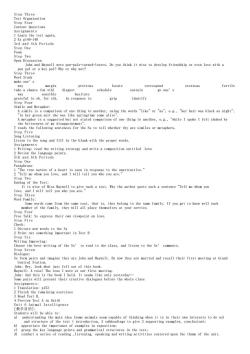
previous schedule locate overseas fertile disgust 出 in response to grip identify in b 品m ppoin g Listening song and fill in the blank with the proper words. riting rea epeyuo rctive you ar re5s epress their o vievpint on love. tenp Five Dictate new words to the 5s Step Seven est writing of the Ss'to read to the class,and listen to the Ss'comments. theya ohn ad Mynel theyredd reall therrstin r 。eae8 ativero4s— eting. Fin ciate the he the the theme of the unit
Step Three Text Organization Step Four Content Questions Assignments 1 Learn the text again. 2 Ex p146-148 3rd and 4th Periods Step One Poem Step Two Open Discussion John and Maynell were pen-pals-turned-lovers. Do you think it wise to develop friendship or even love with a pen pal or a key pal? Why or why not? Step Three Word Study make one’s way margin previous locate correspond overseas fertile take a chance (on sth) disgust schedule sustain go one’s way sensible hesitate grateful to sb. for sth. in response to grip identify Step Four Simile and Metaphor: A simile is a comparison of one thing to another, using the words "like" or "as", e.g., "her hair was black as night"; "in her green suit she was like springtime come alive". A metaphor is a suggested but not stated comparison of one thing to another, e.g., "while I spoke I felt choked by the bitterness of my disappointment". T reads the following sentences for the Ss to tell whether thy are similes or metaphors. Step Five Song Listening Listen to the song and fill in the blank with the proper words. Assignments 1 Writing: read the writing strategy and write a composition entitled Love 2 Review the language points. 5th and 6th Periods Step One Paraphrase 1 "The true nature of a heart is seen in response to the unattractive." 2 "Tell me whom you love, and I will tell you who you are." Step Two Ending of the Text: It is wise of Miss Maynell to give such a test. Why the author quote such a sentence "Tell me whom you love, and I will tell you who you are." Step Three Word Family: Some words come from the same root, that is, they belong to the same family. If you get to know well each member of the family, they will all place themselves at your service. Step Four Free Talk: Ss express their own viewpoint on love. Step Five Check: 1 Dictate new words to the Ss 2 Point out something important in Text B Step Six Writing Improving: Choose the best writing of the Ss’ to read to the class, and listen to the Ss’ comments. Step Seven Dialogue: Ss form pairs and imagine they are John and Maynell. By now they are married and recall their first meeting at Grand Central Station. John: Hey, look what just fell out of this book. Maynell: A rose! The rose I wore at our first meeting. John: And this is the book I held. It seems like only yesterday. Some pairs will present their creative dialogues before the whole class Assignments: 1 Translation: p153 2 Finish the remaining exercises 3 Read Text B. 4 Preview Text A in Unit6 Unit 6 Animal Intelligence [教学目的]: Students will be able to: a) understanding the main idea (some animals seem capable of thinking when it is in their own interests to do so) and structure of the text ( introduction, 3 subheadings to give 3 supporting examples, conclusion); b) appreciate the importance of examples in exposition; c) grasp the key language points and grammatical structures in the text; d) conduct a series of reading ,listening, speaking and writing activities centered upon the theme of the unit

[敦学重点与难点]:Important language points in the text, [教学方法与手段]:采用交互式、讨论式、启发式等教学方法,运用多媒体教学,自主学习中心教师辅导。 [教学时数] 6 periods eetitee:theerle Practice The text is a piece of in Unit3,the purpose of explain 一气a出a。 of those who are in close contact with animals are more convincing than that any experiments can provide. importance of subheadings ard and 4th Periods Step One 2 orangutar tellig eal controversy surround encounter .the lack of negotiate nand switch access envy emergency go wrong size up release 0taeaeal Step Four n anisal intellige Step One in the eye original eiftbeir boro ore tha Step T De tepand subheadings provide natural transitions between paragraphs or sections Step Four Writing Strategy
[教学重点与难点]: Important language points in the text. [教学方法与手段]:采用交互式、讨论式、启发式等教学方法,运用多媒体教学,自主学习中心教师辅导。 [教学时数]: 6 periods 1st and 2 nd Periods Step One Definition: Ss define the concept of intelligence: the power of perceiving, learning, understanding and knowing; mental ability. Step Two Ranking: 1 T dictates the following names of animals to Ss: pig, hen dog, dolphin, elephant, monkey, rat, parrot, cat, ant 2 Ss form groups to rank those animals according to their intelligence, and get ready to explain the rationale behind the ranking. Ss may cite examples, anecdotes, personal experiences, scientific findings, etc 3 T invites speakers from several groups to report to the class. Step Three Listening Practice Questions Step Four Main Idea The text is a piece of expository writing. As mentioned in Unit3, the purpose of exposition is to explain- explain what a certain phenomenon means, how an operation works. The author of this text wants to tell the reader that animals do have, at least, some limited intelligence, and the personal experiences of those who are in close contact with animals are more convincing than that any experiments can provide. Step Five Text Structure Tresses the importance of subheadings Assignments 1 Grasp the learned language points. 2 Ex p177-179 3rd and 4th Periods Step One Culture Notes: 1 gorilla 2 orangutan Step Two Word Study intelligence controversy surround encounter .the lack of it reveal convince dominant make a deal .only to be met with a blank stare negotiate maintain relieve undertake figure out extend expand switch envy in sb’s interest(s) access emergency go wrong size up release Step Three Language Study: Let’s Make a Deal Tale of a Whale Step Four Free Talk Do you or your family or friends have a pet, such as a dog, cat or bird? If so, how does the pet communicate with you or them? Does the pet understand you or them? Assignments 1 Review the learned points. 2 Writing: Animal Intelligence 1) Your opinion on animal intelligence 2) Give one or two examples as supportive evidence 5th and 6th Periods Step One Language Study Primate Shell Game evidence deceive look. in the eye original give in (to sb./sth.) underneath survive wipe out ` .even if their horizons are more limited than ours. Step Two Transitional Devices: Headings and subheadings provide natural transitions between paragraphs or sections. Step Three Check: 1 Have a dictation 2 Home-reading check: Step Four Check: 1 Have a dictation 2 Home-reading check: Step Five Writing Strategy
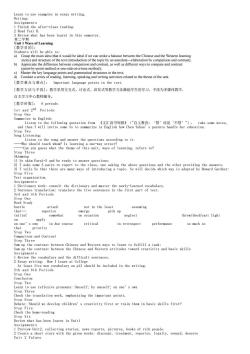
snas之 after-class reading. ys of Learning oft 教学重点与难点 ngactivities related to the theme of then points in the [教学方法与手段]:教学采用交互式、讨论式、启发式等教学方法激励学生的学习,手段为多媒体教学, 自主学习中心教师辅导。 in English and cording to it. Step Three refers to? ss skim P bustle attach not in the legick up assuming somewhat neglect throw/shed/cast light apply critical in retrospect perforaance so much so Step Three and Contrast sth and 6th Periods should be included in the se reflexive pronouns:Oneself:by oneself:on one's ow Step Fehome-reading tep Sia has been learnt in Unitl nit 2 Yalues
Learn to use examples in essay writing. Writing: Assignments 1 Finish the after-class reading. 2 Read Text B. 3 Review what has been learnt in this semester. 第二学期 Unit 1 Ways of Learning [教学目的]: Students will be able to: a) Grasp the main idea (that it would be ideal if we can strike a balance between the Chinese and the Western learning styles) and structure of the text (introduction of the topic by an anecdote—elaboration by comparison and contrast); b) Appreciate the difference between comparison and contrast, as well as different ways to compare and contrast (point-by-point method or one-side-at-a-time method); c) Master the key language points and grammatical structures in the text; d) Conduct a series of reading, listening, speaking and writing activities related to the theme of the unit. [教学重点与难点]: Important language points in the text. [教学方法与手段]:教学采用交互式、讨论式、启发式等教学方法激励学生的学习,手段为多媒体教学, 自主学习中心教师辅导。 [教学时数]: 6 periods 1st and 2 nd Periods Step One Summarize in English: Listen to the following quotation from 《文汇读书周报》("自主教育:‘管’还是‘不管’"), take some notes, and then T will invite some Ss to summarize in English how Chen Yuhua’s parents handle her education. Step Two Song Listening: Listen to the song and answer the questions according to it. -Who should teach whom? Is learning a one-way street? -Can you guess what the theme of this unit, ways of learning, refers to? Step Three Skimming 1) Ss skim Para1-5 and be ready to answer questions: 2) T asks some S pairs to report to the class, one asking the above questions and the other providing the answers. 3) T tells Ss that there are many ways of introducing a topic. Ss will decide which way is adopted by Howard Gardner: Step Five Text organization. Assignments 1 Dictionary work: consult the dictionary and master the newly-learned vocabulary. 2 Sentence translation: translate the five sentences in the first part of text. 3rd and 4th Periods Step One Word Study bustle attach not in the least assuming that.: superior emerge pick up initial somewhat on occasion neglect throw/shed/cast light on apply on one’s own in due course critical in retrospect performance so much so that priority Step Two Comparison and Contrast Step Three Sum up the contrast between Chinese and Western ways to learn to fulfill a task: Sum up the contrast between the Chinese and Western attitudes toward creativity and basic skills Assignments 1 Review the vocabulary and the difficult sentences. 2 Essay writing: How I Learn at College At least five new vocabulary on p13 should be included in the writing. 5th and 6th Periods Step One Conclusion Step Two Learn to use reflexive pronouns: Oneself; by oneself; on one’s own Step Three Check the translation work, emphasizing the important points. Step Four Debate: Should we develop children’s creativity first or train them in basic skills first? Step Five Check the home-reading Step Six Review what has been learnt in Unit1 Assignments 1 Preview Unit2, collecting stories, news reports, pictures, books of rich people. 2 Create a short story with the given words: discount, treatment, reporter, loyalty, reward, deserve Unit 2 Values
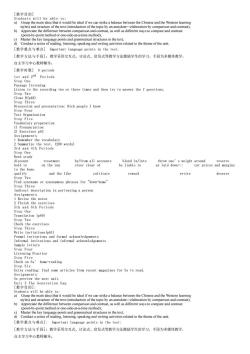
目的] anstrike a balance between the Chine e and the Wes on ofth reated to the theme of theunit. [教学重点与难点】Important1an points in the text. [教学方法与手段]:教学采用交互式、讨论式、启发式等教学方法激励学生的学习,手段为多媒体教学。 自主学习中心教师辅导。 [教学时数]6 periods nd 2nd Periods to the recording two or three times and then try to answer the f questions Step Four P 3rd and 4th Periods y on the run and the like cultivate reward retire deserve s or synonymous phrases fordow-home etr8oceriptiominortraniaeapero a) exercises Practice al est 5s'home-reading trike a balance betwe n the chir and the West of the text (intro tion of the topic 「教学重占与进占1:1 portant language roints in the text: [教学方法与手段]:教学采用交互式、讨论式、启发式等教学方法激励学生的学习,手段为多媒体教学 自主学习中心教师辅导
[教学目的] Students will be able to: a) Grasp the main idea (that it would be ideal if we can strike a balance between the Chinese and the Western learning styles) and structure of the text (introduction of the topic by an anecdote—elaboration by comparison and contrast); b) Appreciate the difference between comparison and contrast, as well as different ways to compare and contrast (point-by-point method or one-side-at-a-time method); c) Master the key language points and grammatical structures in the text; d) Conduct a series of reading, listening, speaking and writing activities related to the theme of the unit. [教学重点与难点] Important language points in the text. [教学方法与手段]:教学采用交互式、讨论式、启发式等教学方法激励学生的学习,手段为多媒体教学, 自主学习中心教师辅导。 [教学时数] 6 periods 1st and 2 nd Periods Step One Passage listening Listen to the recording two or three times and then try to answer the f questions. Step Two Cloze B(p48) Step Three Discussion and presentation: Rich people I know Step Four Text Organization Step Five Vocabulary preparation 1) Pronunciation 2) Exercises p43 Assignments 1 Remember the vocabulary 2 Summarize the text. (200 words) 3rd and 4th Periods Step One Word study discount treatment by/from all accounts blend in/into throw one’s weight around reserve hold to on the run steer clear of be liable to as laid down.: cut prices and margins to the bone qualify and the like cultivate reward retire deserve Step Two Find synonyms or synonymous phrases for "down-home" Step Three Indirect description in portraying a person Assignments 1 Revise the notes 2 Finish the exercises 5th and 6th Periods Step One Translation (p49) Step Two Check the exercises Step Three Write invitations(p61) Formal invitations and formal acknowledgements Informal invitations and informal acknowledgements Sample letters Step Four Listening Practice Step Five Check on Ss’ home-reading Step Six Extra reading: find some articles from recent magazines for Ss to read. Assignments Ss preview the next unit. Unit 3 The Generation Gap [教学目的]: Students will be able to: a) Grasp the main idea (that it would be ideal if we can strike a balance between the Chinese and the Western learning styles) and structure of the text (introduction of the topic by an anecdote—elaboration by comparison and contrast); b) Appreciate the difference between comparison and contrast, as well as different ways to compare and contrast (point-by-point method or one-side-at-a-time method); c) Master the key language points and grammatical structures in the text; d) Conduct a series of reading, listening, speaking and writing activities related to the theme of the unit. [教学重点与难点]: Important language points in the text: [教学方法与手段]:教学采用交互式、讨论式、启发式等教学方法激励学生的学习,手段为多媒体教学, 自主学习中心教师辅导
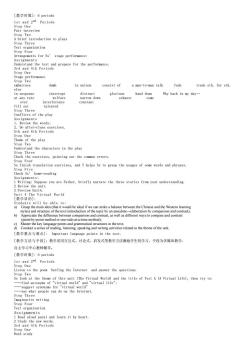
[敦学时数]:6 periods and 2d Periods erview sfor Ss'stage performance in unison consist of a -to-san talk fade trade sth.for sth distract glorious hand down Why back in my day. rate constant exhaust the characters in the play Step Fou translation exercises,and T helps Ss to grasp the usages of some words and phrases. e-reading 公tm心心o。a riting: 目rua1or1a [教学重点与雄点】:Important language points in the text, 「敦学方法与手段]:敦学采用交互式、讨论式、启发式等教学方法激励学生的学习,手段为多煤体教学, 自主学习中心教师辅导。 [教学时数]:6 periods ist and 2d Periods the porf the Ieethe Step Four Read aloud al and learn it by heart ard and 4th Periods e0ay
[教学时数]: 6 periods 1st and 2 nd Periods Step One Pair interview Step Two A brief introduction to plays Step Three Text organization Step Four Arrangements for Ss’ stage performance: Assignments Understand the text and prepare for the performance. 3rd and 4th Periods Step One Stage performance Step Two embarrass dumb in unison consist of a man-to-man talk fade trade sth. for sth. else in suspense interrupt distract glorious hand down Why back in my day. at any rate welfare narrow down exhaust come over interference constant fill out talented Step Three Conflicts of the play Assignments 1. Review the words; 2. Do after-class exercises. 5th and 6th Periods Step One Theme of the play Step Two Understand the characters in the play Step Three Check the exercises, pointing out the common errors. Step Four Ss finish translation exercises, and T helps Ss to grasp the usages of some words and phrases. Step Five Check Ss’ home-reading Assignments: 1 Writing: Suppose you are Father, briefly narrate the three stories from your understanding. 2 Review the unit. 3 Preview Unit4. Unit 4 The Virtual World [教学目的]: Students will be able to: a) Grasp the main idea (that it would be ideal if we can strike a balance between the Chinese and the Western learning styles) and structure of the text (introduction of the topic by an anecdote—elaboration by comparison and contrast); b) Appreciate the difference between comparison and contrast, as well as different ways to compare and contrast (point-by-point method or one-side-at-a-time method); c) Master the key language points and grammatical structures in the text; d) Conduct a series of reading, listening, speaking and writing activities related to the theme of the unit. [教学重点与难点]: Important language points in the text. [教学方法与手段]:教学采用交互式、讨论式、启发式等教学方法激励学生的学习,手段为多媒体教学, 自主学习中心教师辅导。 [教学时数]: 6 periods 1st and 2 nd Periods Step One Listen to the poem Surfing the Internet and answer the questions. Step Two Ss look at the theme of this unit (The Virtual World) and the title of Text A (A Virtual Life), then try to: -find antonyms of "virtual world" and "virtual life"; -suggest synonyms for "virtual world" -say what people can do on the Internet. Step Three Imaginative writing Step Four Text organization Assignments 1 Read aloud para1 and learn it by heart. 2 Study the new words. 3rd and 4th Periods Step One Word study
按次数下载不扣除下载券;
注册用户24小时内重复下载只扣除一次;
顺序:VIP每日次数-->可用次数-->下载券;
- 《大学英语》课程教学大纲A.pdf
- 《大学英语》课程教学大纲C.pdf
- 《大学英语》课程教学大纲B.pdf
- 《大学英语》课程教学大纲A.pdf
- 《大学英语》课程教学课件(讲稿)Unit 2 Language focus.docx
- 《大学英语》课程教学课件(PPT讲稿)unit 2(book 2)answers.pptx
- 《大学英语》课程教学课件(PPT讲稿)Talk about your vacation.pptx
- 《大学英语》课程教学课件(讲稿)Topics for speaking(2024).docx
- 《大学英语》课程教学课件(PPT讲稿)unit 6 answers.pptx
- 《大学英语》课程教学课件(讲稿)Unit 6 words to drill.docx
- 《大学英语》课程教学课件(讲稿)Unit 6 language focus.docx
- 《大学英语》课程教学课件(讲稿)transportation in your hometown.docx
- 《大学英语》课程教学课件(PPT讲稿)How to Talk About Transport.pptx
- 《大学英语》课程教学课件(PPT讲稿)unit 3 answers.pptx
- 《大学英语》课程教学课件(讲稿)Unit 3 words to drill.docx
- 《大学英语》课程教学课件(PPT讲稿)unit 2 answers.pptx
- 《大学英语》课程教学课件(讲稿)Unit 3 language focus.docx
- 《大学英语》课程教学课件(PPT讲稿)unit 1 answers.pptx
- 《大学英语》课程教学课件(讲稿)Time-order signal words and expressions.pdf
- 《大学英语》课程教学课件(讲稿)How to introduce your hometown.pdf
- 《大学英语》课程教学大纲C.pdf
- 《大学英语》课程授课教案(讲义,新视野)Unit 6 Book III NHCE.doc
- 《大学英语》课程授课教案(讲义,新视野)Unit Five Book III NHCE.doc
- 《大学英语》课程授课教案(讲义,新视野)Unit 7 Book 3.doc
- 《大学英语》课程授课教案(讲义,新视野)第四册 Unit 1.doc
- 《大学英语》课程授课教案(讲义,新视野)第二册 Unit 6.doc
- 《大学英语》课程授课教案(讲义,新视野)第二册 Unit 4.doc
- 《大学英语》课程授课教案(讲义,新视野)Unit 7 Book II NHCE.doc
- 《大学英语》课程授课教案(讲义,新视野)Unit Two Book Ⅲ NHCE.doc
- 《大学英语》课程授课教案(讲义,新视野)Unit 3 Book Ⅲ NHCE.doc
- 《大学英语》课程授课教案(讲义,新视野)Unit 3 Book Ⅳ NHCE.doc
- 《大学英语》课程授课教案(讲义,新视野)Unit 1.doc
- 《大学英语》课程授课教案(讲义,新视野)第二册 Unit 3.doc
- 《大学英语》课程授课教案(讲义,新视野)Unit 5 Book 2 NHCE.doc
- 《大学英语》课程授课教案(讲义,新视野)第二册 Unit 2 Book II NHCE.doc
- 《大学英语》课程授课教案(讲义,新视野)第二册 Unit 1.doc
- 《大学英语》课程授课教案(讲义,新视野)第三册教案 Teaching Program Unit 2-9,BookIII.doc
- 《大学英语》课程授课教案(讲义,新视野)第五册教案(Unit 3, Unit 7).doc
- 《大学英语》课程授课教案(讲义,新视野)Unit 7 Book II NHCE.doc
- 《大学英语》课程授课教案(讲义,新视野)Unit 5, NHCE Book I.doc
